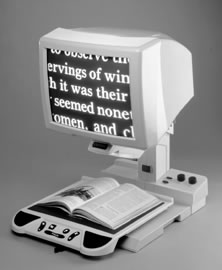Several approaches can be taken to calculate the magnification achieved by a CCTV.10 Total magnification (M) of the CCTV can be calculated from the product of projection magnification (X) and relative distance magnification (Y), M = (X)(Y). X is defined as the print size on the monitor divided by the actual print size of the text (maintaining the same units of measure, e.g., centimeters); Y is the reference distance (25 cm or 40 cm) divided by the working distance in centimeters. Of course, if the reference distance is not designated, it is virtually impossible to determine the total magnification of the system. A cleaner approach in assessing the exact magnification of a CCTV is to determine the equivalent power provided by such a system. This allows the practitioner to obtain the dioptric equivalent of the projection magnification–relative distance magnification interaction. Once the dioptric equivalent is obtained, it is then easy to compare across systems and select systems of equivalent powers for patient evaluation, such as handheld and stand magnifiers, microscopes, or telemicroscopes. Equivalent dioptric power, Deq, equals (X)(Z), where X is the print size on the monitor divided by the actual print size and Z is equal to the dioptric equivalent of the working distance, that is, the reciprocal of the working distance or viewing distance of the patient from the monitor (100/working distance in centimeters). Finally, one can obtain a quick estimate of the amount of projection magnification, disregarding working distance. A piece of graph paper is placed under the camera of the CCTV after the appropriate print size has been established on the screen for a patient's reading needs. Another piece of graph paper is then held up to the monitor, and the regular-size graph squares that fit into the length of one or two magnified graph squares on the screen are counted. By dividing the resultant smaller number into the larger number, the projection magnification can be grossly determined.10
Stand-mounted CCTV systems are commonly configured with television receivers, video monitors, or computer monitors. They provide high-contrast, gray-scale, and inverse video display modes with adjustments for levels of contrast and brightness. The characteristics of enhancement may need to vary with the spatial frequency content of the television picture and the progression of the user's ocular condition.5
Contrast polarities are shown in Figure 1, whereas different contrast intensities are shown in Figure 2. Video displays can achieve contrast of up to 96%.11 Because video image contrast is electronically controllable at levels below the maximum achievable level in a given device, all video displays can be easily adjusted to produce any desired level of contrast intensity less than the maximum. This means that display contrast can usually be set to a level greater than that of the original subject matter before the camera. More importantly, contrast polarity can be easily reversed by an inverting amplifier, usually incorporated in video cameras and in better-quality monitors. These features of contrast enhancement and polarity reversal are unique to video-based visual devices.
|
Handheld systems typically consist of a camera and a control box with a cable to be connected to a TV or video monitor. The user holds the camera and moves it across a page, which often requires sufficient hand-eye coordination. Contrast intensity and polarity can also be controlled on these systems.
Studies have confirmed the overall effectiveness of CCTVs in improving the reading ability of individuals with all levels of visual impairment.12 Sloan,13 in her case report on CCTVs, identified the following advantages of such a system:
- Viewing the screen from a normal reading distance enables people with binocular
vision to avoid excessive convergence demand.
- The zoom lens allows for rapid change in magnification.
- The reversal of contrast to a black background and a white foreground is
often less fatiguing than a white background and a black foreground
because of the decrease in glare.
- The CCTV can be used for handwriting.
- Higher levels of magnification are available than is possible with purely
optical solutions.
- The use of an X-Y table is beneficial for persons with visual restrictions
who have difficulty keeping their place when reading.
However, a common theme stressed in the literature and by practitioners is that the effective use of CCTVs is seldom achieved through mere trial and error; rather, both a comprehensive low vision examination and training in use of the system are critical to success.
The digital revolution has begun to change the design of CCTVs and will continue to do so at an accelerated pace. Images can be enhanced and modified in a multitude of ways, and systems can be endowed with more memory and storage capabilities. These devices may become more popular and useful for orientation and mobility purposes as well.4






